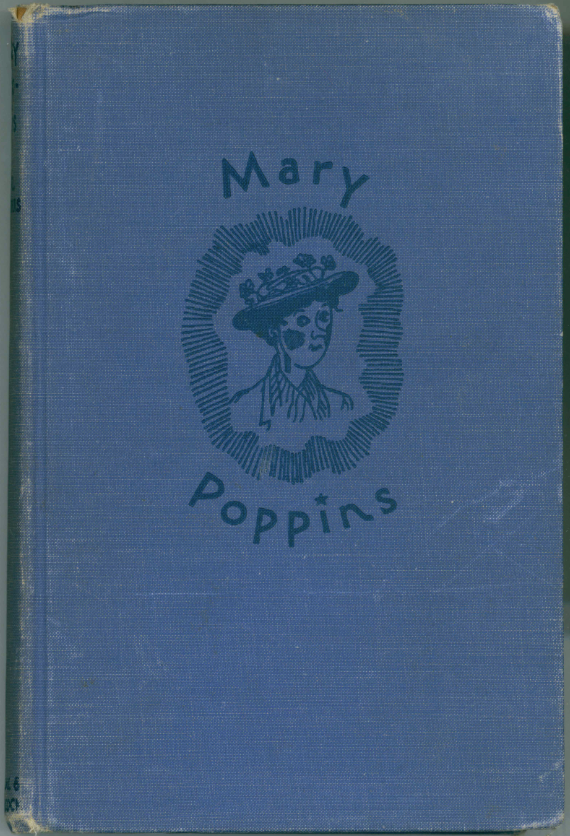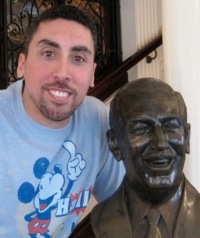Walt Disney once said of stage actress Julie Andrews, “She’s exactly the right woman to play Mary Poppins.” Andrews wasn’t so sure.
 A few middle-aged actresses were considered for the main character in the film based on the P.L. Travers stories, since Travers portrayed her as such. When Walt began to consider perhaps a younger actress would be appropriate for the title role, his secretary recommended Andrews. Andrews was playing Queen Guenevere in Camelot on Broadway at the time, so Walt attended a performance and was immediately impressed. After the show, he visited Andrews backstage and regaled her with the entire plot of his Mary Poppins. In turn, Andrews was impressed with the attention she received from Walt Disney; however, she was uncertain she wanted her film debut to be a nanny with a talking umbrella. She was much more interested in reprising her role as Eliza Doolittle in the upcoming film version of My Fair Lady. She eventually signed with Disney, but continued to hold out hope of being cast in My Fair Lady, so much so that she had a stipulation in her agreement that allowed her to be released from Poppins if Warner Brothers (the studio producing the other film) had decided to cast her.
A few middle-aged actresses were considered for the main character in the film based on the P.L. Travers stories, since Travers portrayed her as such. When Walt began to consider perhaps a younger actress would be appropriate for the title role, his secretary recommended Andrews. Andrews was playing Queen Guenevere in Camelot on Broadway at the time, so Walt attended a performance and was immediately impressed. After the show, he visited Andrews backstage and regaled her with the entire plot of his Mary Poppins. In turn, Andrews was impressed with the attention she received from Walt Disney; however, she was uncertain she wanted her film debut to be a nanny with a talking umbrella. She was much more interested in reprising her role as Eliza Doolittle in the upcoming film version of My Fair Lady. She eventually signed with Disney, but continued to hold out hope of being cast in My Fair Lady, so much so that she had a stipulation in her agreement that allowed her to be released from Poppins if Warner Brothers (the studio producing the other film) had decided to cast her.When TV funnyman Dick Van Dyke was suggested for the role of Bert, Walt had confessed that he had never seen his program. After watching just a portion of The Dick Van Dyke Show, Walt immediately decided to cast Van Dyke, who didn’t play nearly as hard-to-get as Andrews did. He even wanted to play a second role, that of Mr. Dawes Sr., the elderly bank chairman. Walt enjoyed the footage he saw of Van Dyke playing an “old man," but he still needed a little convincing.
“I told Walt I wanted to play the old man’s part so much that I wouldn’t charge him a nickel,” Van Dyke recalled. “Walt liked my screen test, but being the old horse trader that he was, he told me I had to donate $4,000 to Cal Arts if I wanted to play the old man. I gave him the money happily.”
When it came time to write the songs for Mary Poppins, Walt didn’t hesitate in calling upon the special talents of songwriting brothers Richard and Robert Sherman. He gave them a copy of the book to get their thoughts, which resulted in quite the happenstance. “Dick and I chose six chapters in the book, and, after two weeks, we went to Walt with our ideas,” Robert Sherman remembered. “We pointed out the six chapters that might work, and he smiled, leaned back to get his own copy, and showed us that he had marked the same six chapters. That was a wonderful feeling.”
Walt and the Sherman Brothers were often on the same wavelength, perhaps never more so than during the production of Mary Poppins. One day after scanning the various stories written by P.L. Travers, a certain character caught the attention of the two brothers: an old woman selling bread crumbs. “Feed the birds,” she’d say, “tuppence a bag.” They felt that was a metaphor for the entire film. “A little extra kindness—it doesn’t take much.” That seemingly inconsequential character went on to inspire one of Walt’s all-time favorite songs in Feed the Birds. “Usually, after a hectic week, Walt would ask us how we were doing, and we’d tell him what we were working on,” recalled Robert Sherman. “Then he’d ask us to play it, and I’d sit down and play, and he’d look out the north window and get wistful. Then he’d turn around and say, ‘That’s what it’s all about, isn’t it? Well, have a good weekend, boys.’ ”
Walt had his hands in virtually every aspect of the production of Mary Poppins. It started with the script itself, which was replete with his notes. Removing scenes, altering existing ones, and re-wording bits of dialogue are just some of the changes Walt suggested, and almost all of Walt’s “suggestions” found their way into the film. This was not only because he was the boss, but also because his ideas were brilliant. He also made it a point to walk through the sets once they were completed. One day he found himself in the Bankses’ living room, looking for fun ways for the family to react after the firing of Admiral Boom’s cannon. According to co-writer Bill Walsh, Walt said, “How about having the vase fall off and the maid catches it with her toe?” And, “Let’s have the grand piano roll across the room and the mother catches it as she straightens the picture frame.” Walt also worked in things, such as Van Dyke’s “old man stepping down stairs” routine from his screen test, detailed actions of the cartoon characters in the animated sequences, and much more. During the production, he also found time to wheel in a cake for actress Karen Dotrice’s (Jane Banks) ninth birthday, and helped her cut it.
While there is no such thing as a perfect film, Mary Poppins is about as close as they come—"practically perfect, in every way," as one might say. Terrific performances, amazing effects (including gorgeous matte paintings by Peter Ellenshaw, who took home an Academy Award for Best Effects, Special Visual Effects), wonderful music provided by the Sherman Brothers (who won the film two of its five Academy Awards for Best Music: Substantially Original Score and Original Song, "Chim Chim Cher-ee") flawless animation mixed with live-action, and of course “Walt’s touches” all helped to ensure the film’s unequivocal critical and box-office success. And with success, there came renewed admiration for Walt and his studio. Not long after the release of Mary Poppins, Walt was entertaining a group of industrialists at the studio commissary. When their excessive praise of Walt began to make him uncomfortable, future Disney Legend Donn Tatum tried to help him out by cracking a joke: “Well, Walt, there’s only one thing left for you to do, and that’s to walk on water.”
“I’ve already tried that,” Walt replied, “and it doesn’t work.”

Keith Gluck is a volunteer and frequent guest blogger at The Walt Disney Family Museum. Keith is the writer/editor for thedisneyproject.com, a Disney fan site. His Disney life started early, visiting Disneyland before turning one, and writing his very first book report on a Walt Disney biography for kids.
